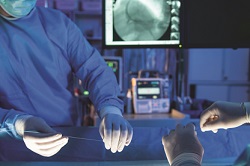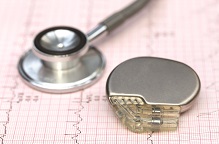
 Utilization of smaller, wearable and more portable diagnostic and treatment equipment is making it possible for an aging U.S. population to access treatment without being restricted to clinics, hospitals or the offices of doctors.
Utilization of smaller, wearable and more portable diagnostic and treatment equipment is making it possible for an aging U.S. population to access treatment without being restricted to clinics, hospitals or the offices of doctors.
Design and development of the smaller, more sophisticated devices is being driven by an increasing number of healthcare services delivered in the home to disabled, chronically ill, recovering or terminally ill individuals.
Industry Overview
Globally, the medical device industry represents over $306 billion and is comprised of the manufacture of a vast range of surgical appliances, orthopedic instruments, optical diagnostic equipment, syringes, implants, needles catheters, test strips, electro-medical equipment, ultrasound devices and other patient-monitoring devices.
The United States is the largest medical device manufacturer in the world with over $138 billion in annual revenues (45 percent of the global medical device market).
Manufacturing facilities are as small as 15 or 20 workers to large global conglomerates such as Johnson & Johnson.
Requirements for these new product designs are beginning to look more like those for consumer products, including fine-pitch component placement, high-volume automated assembly and sophisticated test techniques.
Throughout the industry, mergers and acquisitions are creating deeper connections from research and development through production. Teaming this continued trend with the uncertainty of new healthcare laws coming into effect will undoubtedly continue to create challenges where economic development professionals can assist.
Industry Drivers
Demographics: The largest segment of the patient population is roughly 76 million aging baby-boomers. An increasing percentage of this population is choosing to live independent, non-institutionalized lives, receiving home-care services. Roughly two in three of Americans over the age of 62 have at least one chronic disease. Of the medical issues being experienced by this population group, heart disease, diabetes and respiratory problems rank the highest.
Demand for medical devices that target cardiac therapy, diabetes, patient monitoring and pain management is growing and sustainable.
Thus, the trend in medical device technology is accelerating steadily toward portability and delivery of care at the bedside or in the home. In turn, the development of next-generation monitoring, display, diagnostic and therapeutic equipment designed to be more compact, accurate and versatile is also growing.
Systems are gearing toward a prevention-oriented, consumer-driven model for healthcare that includes innovations such as smart devices that can "think" for themselves: customized wearable devices, electronic patient records and wireless Internet-linked systems — all expected to deliver convenient, user-friendly, intelligent healthcare in the home.
The idea is to make patients independent of their physician, to give them the opportunity to conduct simple measurements on their own and to actively participate in their healthcare — all while leading a more normal life. Patient wearable products in cardiac pacing, pain management, drug delivery, blood chemistry monitoring (blood pressure, glucose and oxygen), auditory therapy and neural monitoring and stimulus are already on the market.
All of these products rely on an advanced array of sensor technology and microprocessor-based decision-making algorithms to evaluate patient conditions and administer the appropriate therapy when needed.
The impact of sensor-driven technology is even present in products that have never been electronic, such as oxygen bottles. An example would be a Canadian company that is developing a battery-operated, wearable oxygen concentrator. Designed to fit into a belt pack, the system takes normal atmospheric air and strips out the nitrogen, delivering highly concentrated oxygen. The product relieves patients of the burden of carrying around bulky and heavy oxygen bottles.
Product Design Trends
In addition to FDA regulations, five significant trends in device design are emerging: smaller, wearable/implantable, wireless, reliable and intelligent. These trends frequently impose constraints and, occasionally, conflicting challenges to medical device design.
Smaller: Devices worn by patients must, by design, be light and small enough to be unobtrusive when worn. To accommodate these design criteria, the overall dimensions of the instrument require minimized size and weight.
Key features and functions of these devices include:
-
High-speed microprocessors or microcontrollers for onboard intelligence, analysis and control
-
Data-logging memory to store and download patient measurements
-
Advanced electrical, chemical, physical or optical sensors to monitor patient parameters
-
Wired and wireless communication, including Ethernet, USB, RS-232, WMTS, Bluetooth, WiFi (802.11), IR, GSM, and GPRS
-
Battery-operated, with rechargeable batteries
-
Simple, iconic, numeric or graphical user interface with either a monochrome or color LCD display.
The need for micro miniaturization extends beyond just the electronics and includes areas such as microfluidics and small-scale mechanical and optical components. Emerging technology such as Micro-Electro-Mechanical Systems (MEMS), and even nanotechnology components are being developed for medical and biomedical applications.
Fortunately, many of these technologies have been developed and perfected for small consumer electronics products, such as cell phones, where volumes and overall economies of scale make the investment in technology development worthwhile.
Wearable/Implantable: Patient wearable or implantable medical devices typically rely on batteries as the primary power source. After size, the overall power budget for the device directly affects the size of the battery and service life of the device. Wearable devices can have rechargeable batteries, but for implanted devices that use a battery for their primary source of power, battery life is critical: every replacement requires a surgical procedure. Inductive charging might be an option, but relies on the user/patient having access to a charging device whenever necessary, which is an inherent risk factor.
 Wireless: Whether in the hospital, at a physician’s office or at home, medical devices are going wireless. A variety of technologies are being deployed, including WMTS, Bluetooth, WiFi (802.11), GPRS, GSM, and IR. The reason is simple: untethered ambulation; allowing the patient the freedom to move about the hospital room or at home without being tied up in cables.
Wireless: Whether in the hospital, at a physician’s office or at home, medical devices are going wireless. A variety of technologies are being deployed, including WMTS, Bluetooth, WiFi (802.11), GPRS, GSM, and IR. The reason is simple: untethered ambulation; allowing the patient the freedom to move about the hospital room or at home without being tied up in cables.
The wireless links are two-way: for downloading programming or calibration data to the device, and for extracting measurement data from the device. In many cases, the patient data is fed into a PC for analysis, and may even be transferred to a central patient records database in the hospital or doctor’s office.
Some new products can be monitored and controlled from a remote location, allowing a physician direct access to the patient information without having to be present. These devices record patient information such as blood pressure measurements and then transmit that information either over a computer line or wirelessly to the patient’s healthcare provider.
Reliable: Medical devices, particularly those that are life sustaining, must have high reliability. Useful product life can extend to three to five years. Implantable devices cannot be repaired; they must be replaced if they fail, and replacement requires surgery. Even wearable devices may not be repairable.
Now with more patient wearable devices (as opposed to clinical or laboratory devices), the need for ruggedness is increasing. Once outside the protective confines of a hospital or clinic, the use environment is hostile. Many of these devices undergo constant use, 24x7. They are subjected to shock, vibration, dropping, misuse, sweat, dirt, contaminants and water (shower, bath or pool). For many devices, an IP rating of 65 or better is desirable.
Intelligent: Medical devices are getting smarter. Embedded microprocessors, SOC (System On a Chip), SBC (Single Board Computers), integral PDAs and advanced sensor technology are all common elements of today’s medical devices. The computing power is required to support the sensor management, signal processing, data collection and analysis, wired and wireless communications and user interface displays used on new devices.
As clock speeds increase with advances in microprocessor design, the higher frequencies make EMI and EMC compliance more difficult to achieve. Shielding and noise immunity become a bigger challenge.
Some of the more sophisticated sensor technology being used today requires extremely low-level measurements — electrical, optical, thermal, chemical and biological. Noise immunity, suppression and isolation become significant challenges, requiring complex algorithms and DSP.
Site Selection Criteria
Changes in workforce, continuing tightening of the regulatory environment and unknown impacts of the new healthcare laws are all factors that the medical device manufacturing industry are facing as they move through acquisitions, mergers, consolidations, relocations and expansions. Decisions are being made to cut workforces or hold off on expansions.
Site selection will follow industry trends and key criteria will need to be considered with the highest scrutiny, as industry experts weigh what unfolds with the healthcare plans and its effects on medical device manufacturing. To make up for the incurrence of additional manufacturing taxes, reducing costs in different places will become an even higher priority.
Based on a Geneva Analytics survey of 17 manufacturing firms, several key site selection criteria emerged as benchmarks by medical device manufacturing firms analyzing potential locations for facilities. Those factors include:
-
Energy Costs: The use of energy in the manufacturing process requires a close examination of utility costs in potential facility locations.
-
Supplier Network Infrastructure: Any type of manufacturing, especially a technology-laden form such as medical manufacturing, requires a strong support system of suppliers – particularly in the areas of machine tooling, equipment maintenance/refurbishment, component production and engineering.
-
Transportation Costs: The need for excellent road and sometimes rail infrastructure to transport raw materials from suppliers and finished product to customers is vital to medical manufacturing companies.
-
Real Estate: Available and “ready for development” real estate sites or buildings are critical to grow medical manufacturing companies.
-
Property Tax Rates: Large investments in facilities and equipment make property tax costs an important part of the analysis of ongoing operating costs.
-
Research Universities: Life sciences companies, including medical manufacturers, often want proximity to higher educational institutions to develop and/or license technology, develop a pipeline of new employees and to solve manufacturing challenges.
-
Labor Force: A skilled workforce is vital for medical manufacturing – being able to hire, train and retain employees who can adapt to new technology is very important.
-
Community Amenities: In many cases, medical manufacturing projects involve the relocation of employees to the selected community – in addition, life sciences companies desire to be in communities where they can attract people from the region to come to work.
-
Economic Development Incentives: Due to the capital-intensive nature of the industry, economic development incentives that can reduce project and operating costs can have a profound impact on site selection decisions.
Conclusions
The Northeast and Midwest have long dominated the medical manufacturing industry. Due primarily to the availability of the established skill base of the workforce, proximity to supplier networks and access to excellent transportation infrastructure, these geographic areas should continue to hold a leadership position.
Continued growth of the healthcare industry has also spurred cluster development in the Southeast, Mountain and Southwest regions of the United States. These regions will continue to be significant players in the industry sector.
Life sciences and medical device manufacturing companies tend to cluster around one another. This form of “coopetition” allows businesses to leverage supplier networks, higher educational institutions, labor force and other key infrastructure required by this industry sector.
Areas that already have an intrinsic understanding of the highly complex regulatory environment, the educational base for technologically and high-level workers will naturally be more suited to attract and sustain life sciences and the medical device manufacturing industries.

